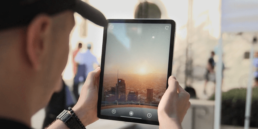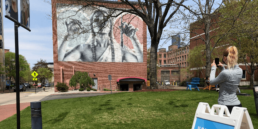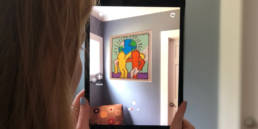This summer, Hoverlay teamed up with Northeastern and MIT storytelling experts to bring 4 local stories across Toronto to life, using Augmented Reality, and share them with people in their neighborhoods.
The project was part of Northeastern “Dialogue of Civilizations” program, led by documentary film maker David Tames. The project taught the students how to tell stories using augmented reality. After learning AR creation in Hoverlay app, students created four AR channels for four local nonprofits.
Students worked with “Newcomer Kitchen”, a nonprofit helping female Syrian refugees to integrate by cooking meals from their region, and then share the proceeds from their sale. The idea behind this AR experiences is to attach to the meals an AR experience telling the story of the people behind the food to create a direct connection between the refugees and people in the city who experience their cooking.
Watch a video below recorded at the site to see their work:
Another group of students worked with “Convenience Stories,” a nonprofit that strives to inspire people to shop at corner stores in Toronto and help them survive gentrification. The students created an AR channel that enables users to learn more about the corner stores on Queen Street in Toronto, including descriptions of each shop, interviews with the owners, and Yelp reviews.
Watch a video recorded at the site to find out how they created it:
The group of students worked with the community partner “Building a Better Bloor Dufferin” an organization that consists of residents, businesses, and artists who are concerned about the current decision the government plans to do with the local land. Students created green screen and full screen videos with residents and high school students talking about their views on area’s history and planned demolition. AR holograms and videos were placed at the various sites via Hoverlay channels along the way to help users find and explore their reasons and passions as to appreciating the place and its history.
Watch a video recorded at the site:
The last group of students worked with “Build for Bokma” foundation, a group of skateboarders-turned-activists, focused on turning unused urban spaces into community skate. Their vision is to place augmented content on those unused urban spaces to educate on the importance of having skateparks and safe places for kids, and create awareness for their mission. To convey this message, they placed a combination of 3D models of the skatepark, videos, and audio narrations.
Watch a video recorded at the site to see their work:
Cindy Bishop from MIT Media Lab who collaborated with Northeastern and Hoverlay team concludes on her great blog: “AR can and will vascularize lackluster calls-to-action especially if these calls are connected to a place and space — if we solve for the problem of the right place at the right time and as quick and as painlessly as possible. The way-finding and sense-making, how can we connect the audience to the authenticity of people, place and problem/puzzle at a time in which they are willing and able to pay attention. “
Hoverlay team was very excited and humbled to be a part of this great educational and public engagement project. Augmented reality gives us new ways to tell stories about places and people of local communities that would lead to more civic engagement.
To download the Hoverlay App visit: https://itunes.com/apps/hoverlay
Hoverlay is a new way to distribute and share digital content, social and professional profiles, video and images, by simply placing it into the world. Using the Hoverlay camera, anyone can find, interact, and collect content using augmented reality. Read more at https://hoverlay.com/ or follow Hoverlay on Twitter at @hoverlayAR



